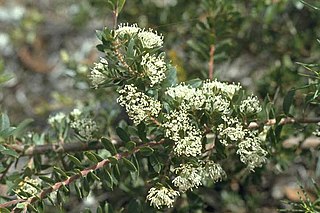
Hibbertia serrata, commonly known as serrate-leaved guinea-flower, is a shrub that is endemic to the south-west of Western Australia. It grows to between 0.1 and 2 metres high and has yellow flowers which appear between August and December in the species' native range.

Hibbertia miniata, commonly known as orange flower, is a small shrub in the family Dilleniaceae and is endemic to Western Australia.
Hakea ilicifolia is an open shrub or tree in the family Proteacea and is endemic to Western Australia.

Hakea ruscifolia, commonly known as the candle hakea, is a shrub in the family Proteacea. It has fragrant white flowers, arching branches and spiky foliage. It is endemic to an area in the Peel, Wheatbelt South West, Great Southern and the Goldfields-Esperance regions of Western Australia.

Hibbertia acerosa, commonly known as needle leaved guinea flower, is a species of flowering plant in the family Dilleniaceae and is endemic to the south-west of Western Australia. It is a low, spreading or ascending shrub typically growing to a height of 10–60 cm (3.9–23.6 in) and has yellow flowers from July to December or from January to February.
Hibbertia acrotrichion is a species of flowering plant in the family Dilleniaceae and is endemic to a restricted area of Western Australia. It is a small, erect shrub with linear, cylindrical leaves and yellow flowers arranged singly in leaf axils with eleven stamens arranged in groups.

Hibbertia amplexicaulis is a shrub in the Dilleniaceae family that is native to Western Australia.
Hibbertia ancistrophylla is a shrub in the Dilleniaceae family that is native to Western Australia.
Hibbertia ancistrotricha is a shrub in the Dilleniaceae family that is native to Western Australia.
Hibbertia andrewsiana is a shrub in the Dilleniaceae family that is native to Western Australia.
Hibbertia arcuata is a shrub in the Dilleniaceae family that is native to Western Australia.
Hibbertia argentea is a shrub in the Dilleniaceae family that is native to Western Australia.
Hibbertia carinata is a shrub in the Dilleniaceae family that is native to Western Australia.
Hibbertia ferruginea is a shrub in the Dilleniaceae family that is native to Western Australia.

Hibbertia commutata is a shrub in the Dilleniaceae family that is native to Western Australia.
Hibbertia crispula is a shrub in the Dilleniaceae family that is native to Western Australia.
Hibbertia cunninghamii is a shrub in the Dilleniaceae family that is native to Western Australia.
Hibbertia depressa is a shrub in the Dilleniaceae family that is native to Western Australia.

Hibbertia subvaginata is a small shrub that is endemic to Western Australia.

Hibbertia acicularis, commonly known as prickly guinea-flower, is a species of flowering plant in the family Dilleniaceae and is endemic to eastern Australia. It is an erect or prostrate shrub with linear to lance-shaped leaves and yellow flowers arranged singly in leaf axils with the six to eight stamens joined at the base, in a single cluster.








